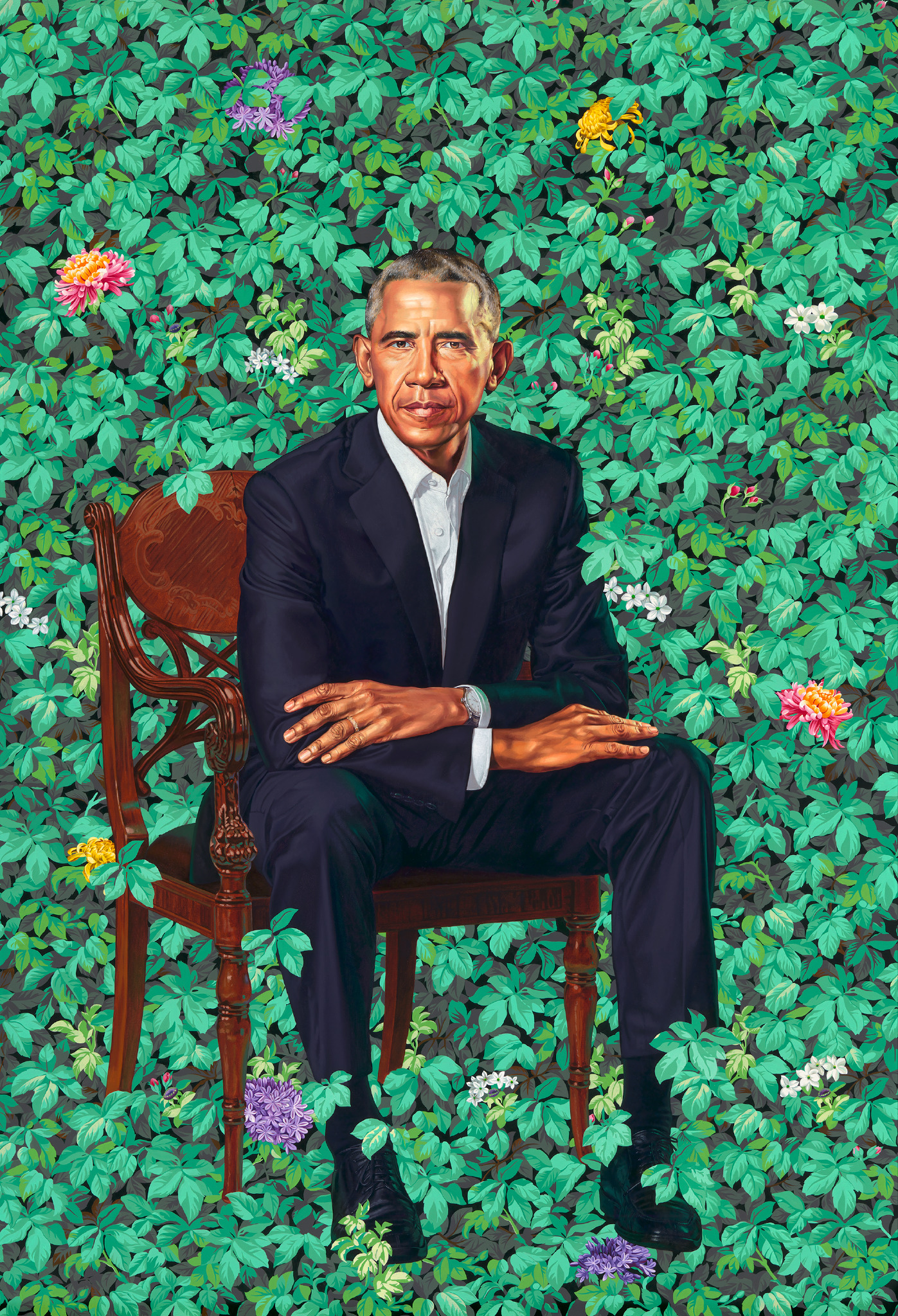The portraits don’t look like the portraits that came before them, but of course, neither do their subjects.
On Monday morning, former President Barack Obama and former first lady Michelle Obama attended the unveiling of their official portraits at the National Portrait Gallery, alongside the artists who the Obamas selected for the task: Kehinde Wiley and Amy Sherald, respectively. Wiley and Sherald are the first African-American artists to be commissioned for the NPG’s official portraits of a president or first lady.

President Obama leans forward on a wooden chair, looking a little casual — jacket, no tie — but alert, focused. He is surrounded by greenery on all sides, seemingly on the verge of engulfing him entirely. As Wiley explained in his speech, the foliage is laced with references to Obama’s personal history: African blue lilies for his Kenyan father, jasmine for his Hawaiian home, and chrysanthemums, the official flower of Chicago, for the city where he met his wife, where his daughters were born.
When Wiley and Obama unveiled the portrait, the audience gasped.
In Sherald’s portrait, Michelle Obama’s skin is rendered in gray — Sherald gave the former first lady the same treatment she gives all her subjects — and her dress, save for a few slices of color, is black and white. Her dress is by Michelle Smith’s label Milly. In this moment in which women are grappling with the insidious effects of living with the male gaze, Michelle Obama’s portrait is female through and through: Her female form is wearing a female artist’s design, all immortalized by a female painter.
And though at first her face, among the most recognizable visages in the world, doesn’t seem to resemble her exactly, the longer you look at the painting, the more Michelle looks like Michelle. This, too, feels like an echo of Michelle Obama’s rise on the national stage: A woman who didn’t initially scan as warm or likable enough left office with approval ratings that dwarfed her husband’s.
It’s worth thinking about how the Obamas arrived at the White House at the dawn of the social media age; they were the first president and first lady to have Instagram, Facebook, and Twitter accounts. For eight years, countless photographs of the two of them were disseminated across these social networks. (And these pictures continue to circulate widely on social media with some help from former White House photographer Pete Souza, who loves nothing more than to re-up an Obama image as commentary on his boss’ successor.) Maybe that gives these portraits the space to be less literal, to get at the essence of these individuals — to not attempt to replicate what photography has already, thoroughly done.

Wiley delights in elevating his subjects to hero-status in his art, decking them out with the armor of royalty, in pomp-and-circumstance worthy poses. He often paints ordinary people he spots on the street, though he’s also known for his portraits of stars. (Take his portrait of Michael Jackson, in which the pop icon is shown “on horseback, wearing the armor of a Habsburg king, crowned by angelic flying figures,” writes the Washington Post.) As the New York Times put it, Wiley “adapts a historical style of portraiture that was rarely used to celebrate black people, and presents them, in all of their everyday glory, in grand and opulent colors. His paintings are jolting because they imagine a new way of historicizing and visualizing black people.”
Sherald, who is Baltimore-based, also paints black Americans, all of whom (save, now, for the former first lady) are civilians, not celebrities. Her subjects typically stand alone, eyeing the viewer, their gray skin against a brightly-colored background. She elevates the ordinary with the simple but powerful gift of her undivided attention, asking audiences to consider people they typically overlook.
During the unveiling ceremony, President Obama joked about walking back Wiley’s impulse to show the former Commander-in-Chief “in this situation with partridges and scepters and thrones, or mount me on a horse. I had to explain that I’ve got enough political problems without him making me look like Napoleon. I said, ‘bring it down just a touch.’ And that’s just what he did.”
As for Sherald’s work, President Obama referred to his wife’s “hotness” not once but twice, first to thank Sherald “for so spectacularly capturing the grace, beauty, intelligence, charm and hotness of the woman I love,” and then when he thanked his mother-in-law for providing Michelle’s “hotness genes.” (Surely Sasha and Malia almost spontaneously combusted from cringing so hard at this extremely dad turn of phrase; please keep them in your thoughts and prayers during this mortifying time.)
That Sherald is painting at all, let alone completing such an extraordinary commission, is no minor medical miracle: In 2012, she had a heart transplant after collapsing on a pharmacy floor. As the Baltimore Sun reported, “It took her about a year to build up her strength enough to allow her to resume painting.” And before that, she’d needed to take three years off from painting to care for sick family members.
Michelle Obama was struck by Sherald’s “extraordinary character and strength,” she said at the ceremony, hailing Sherald as “well on her way to distinguishing herself as one of the great artists of her generation.”
For her part, Sherald said, “I paint American people, and I tell American stories through the paintings I create. Once my paintings are complete, the model no longer lives in the painting as themselves. I see something bigger, more symbolic, an archetype.”
“Mrs. Obama, you are omnipresent,” Sherald said. “You exist in our minds and hearts because we can see ourselves in you.”
The portraits will open to the public at 10:00 a.m. on Tuesday, February 13.
